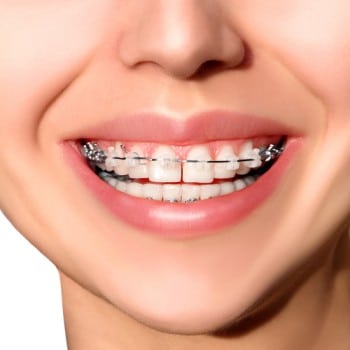If you read our blogs, you will probably notice a pattern forming when it comes to answering “best” questions. With the rapid technological advances and explosion of newer material available to make braces in the last 100 or so years, choosing among the options for braces really comes down to clients’ needs and expectations, as well as their budgets.
Here’s a look at the available materials used in modern orthodontics and how they can benefit the wearer.
Metal
“Traditional” braces are ordinarily composed of high-grade stainless steel. Metal braces remain the most common because they are least expensive and highly effective at correcting almost all types of malocclusions.
Metal braces have also become a lot smaller. Makers have created a broad range of shapes and styles (including a gold-plated option), as well as colorful accessories, allowing wearers to personalize their look and take ownership of the braces experience.
There is a slight chance that a wearer might exhibit an allergic reaction to the stainless steel or the alloys used in the braces, with nickel usually being the culprit. It is worth discussing this with your orthodontist if you think you might be allergic.
Ceramics
The glass-like composite used in these braces makes them slightly more expensive than traditional braces. But thanks to the translucent material, the “clear” or “tooth-colored” brackets have cosmetic appeal for more self-conscious wearers who would like to keep their braces out of the limelight.
There are some things to consider with these braces, though. Ceramic braces are also more prone to breaking as they are composed of a more fragile material. To compensate for the brittleness, they are also bigger than their metal counterparts. The greater friction of the wire against the ceramic also slows down treatment times.
Combination
Modern braces (the brackets that attach to teeth) also come in combinations with metal reinforced ceramics and plastic.
Plastics
These braces are another clear alternative for wearers who like to keep their braces a secret. Comprised of ceramic- or fiberglass-reinforced polycarbonate (with metal slots), they have a the transparent, “tooth-colored” appearance.
Polycarbonate braces can sometimes discolor over time depending on diet and habits. Like the ceramic braces, the friction index between the bracket and the wire is also high, which can mean longer treatment times.
There are also composite plastic archwires that, ironically, have no wire in them. This non-metallic archwire is composed of three separate materials with a transparent, stain-resistant exterior. They are remarkably strong and can be used in any type of braces.
Plastic Trays
Made from polypropylene, these retainer-style plastic trays (known as aligners) are molded to fit over the teeth, with the most popular brand being Invisalign®. Patients frequently opt for this type of brace because they are clear and removable for dental hygiene and eating. However, they are not as effective in complex orthodontic procedures and for certain malocclusions.
Orthodontic Associates offers a wide range of braces to accommodate the needs as well as the particular tastes of our patients. Contact one of our friendly staff members to set up a consultation at any one of our nine convenient orthodontic offices around Baltimore to see how we can help you get your healthy bite and perfect smile. We look forward to making you smile!



